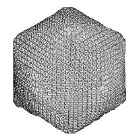Plant Pathology, Department of

James Van Etten Publications
Document Type
Article
Date of this Version
2019
Citation
Published in Journal of Biological Chemistry, April 5, 2019, vol. 294, no. 14, pp 5688-5699
doi: 10.1074/jbc.RA118.007182
Abstract
The chlorovirus Paramecium bursaria chlorella virus 1 (PBCV-1) is a large dsDNA virus that infects the microalga Chlorella variabilis NC64A. Unlike most other viruses, PBCV-1 encodes most, if not all, of the machinery required to glycosylate its major capsid protein (MCP). The structures of the four N-linked glycans from the PBCV-1 MCP consist of nonasaccharides, and similar glycans are not found elsewhere in the three domains of life. Here, we identified the roles of three virus-encoded glycosyltransferases (GTs) that have four distinct GT activities in glycan synthesis. Two of the three GTs were previously annotated as GTs but the third GT was identified in this study. We determined the GT functions by comparing the wild-type glycan structures from PBCV-1 with those from a set of PBCV-1 spontaneous GT genes mutants resulting in antigenic variants having truncated glycan structures. According to our working model, the virus gene a064r encodes a GT with three domains: domain 1 has a β-L-rhamnosyltransferase activity, domain 2 has an α -L-rhamnosyltransferase activity and domain 3 is a methyltransferase that decorates two positions in the terminal α -L-rhamnose (Rha) unit. The a075l gene encodes a β -xylosyltransferase that attaches the distal D-xylose (Xyl) unit to the L-fucose (Fuc) that is part of the conserved N-glycan core region. Lastly, gene a071r encodes a GT that is involved in the attachment of a semiconserved element, α-D-Rha, to the same L-Fuc in the core region. Our results uncover GT activities that assemble four of the nine residues of the PBCV-1 MCP N-glycans.
Includes supplemental material.


Comments
Copyright © 2019 American Society for Biochemistry and Molecular Biology
Used by permission.